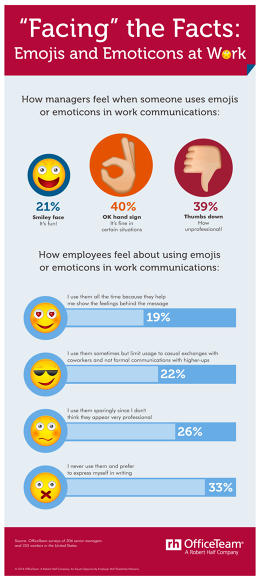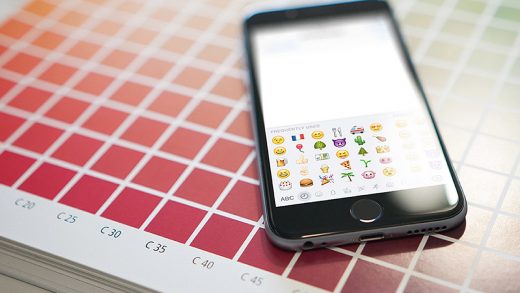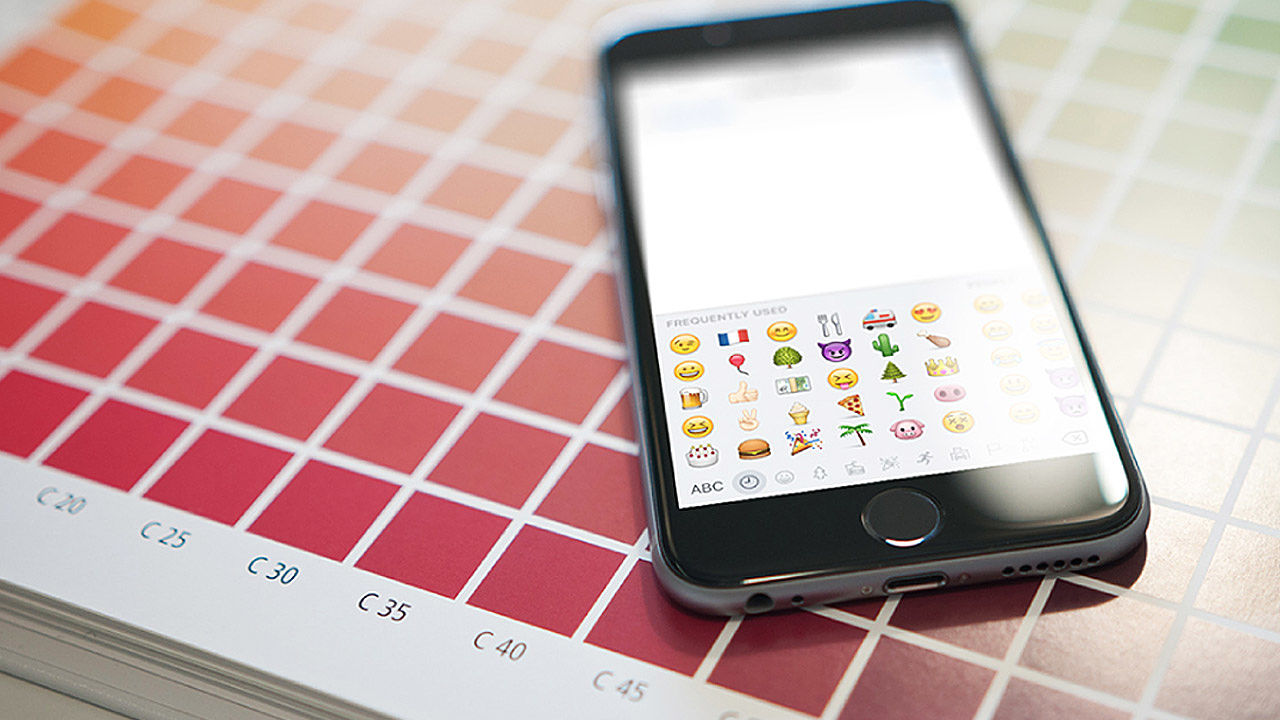The Business Etiquette Guide To Emojis
When was the last time you added a smiley or some other small graphic as a stand-in for words in a message to your boss or coworkers? Chances are it was pretty recent: A recent study found that nearly half (41%) of workers use emojis in professional communications. And among the senior managers polled, 61% said it’s fine, at least in some situations.

The study was conducted by OfficeTeam, a temp staffing service that’s a division of Robert Half. It included responses from more than 300 senior managers at U.S. companies with more that 20 employees, and more than 350 U.S. workers who are employed in office environments.
Of the managers surveyed 21% found the use of the “smiley face” fun, 41% said the “OK” hand sign was fine in certain situations, and 39% found the “thumbs down” unprofessional. Only 19% of employees admitted to using them all the time to indicate the emotion behind their professional communications. Thirty-three percent said they eschew the graphics entirely and prefer to express themselves through their words.
The challenge is that a written expression of emotion in emails, texts, or even less asynchronous chats, isn’t always received in the spirit it was intended. Even teams who are accustomed to working remotely won’t always get a humorous reference or sarcasm, in large part because they only know each other digitally. So it’s no wonder that emojis have become a common crutch to try to express our feelings.
The problem is that emojis are a relatively new addition to the correspondence scene and no formal rules have been established. Etiquette’s OG Emily Post (as written by Anna Post) is dismissive:
“To smiley or not to smiley, that is the question. Unless you are absolutely certain an emoticon will be received well, avoid using them. To unsympathetic eyes, or simply to someone who doesn’t know you well, they look juvenile in business.”
For those of us who rely on group chat platforms like Slack to get work done, that suggestion simply doesn’t make sense. Fast Company recently covered some of the finer points of communication on Slack. In light of this study, we took a deeper dive into burgeoning emoji use and asked some professionals who work with remote teams for their best practices.
Caileen Kehayas, content marketing manager at Proven
Kehayas tells Fast Company that the San Francisco-based startup moved to have all its staff work remotely two months ago. She says that working with someone you have never met face to face is much like working with someone you have met in real life. For both, it pays to experiment.
“You will feel out what kind of humor or small talk someone likes and how they like to interact,” she says. Starting with a simple smile could do the trick. “If they are joining a new, established team, a few well-selected emojis could be a great, friendly way of saying ‘welcome,’ she says.
A few well-placed emojis can pretty successfully replace a hug or verbal well-wishes when remote, says Kehayas. Also:
Do: Use emojis to infuse your emails or Slack messages with personality. When you are not dealing with face-to-face interactions on a daily basis, any word can be misconstrued. There is a big difference between a plain “Yes,” and “Yes” with a smiley and “Yes” with the sunglasses smiley and the 100. Use emojis in these scenarios to let some personality shine through.
Do: Pile on the emojis for special occasions.
Did your coworker get engaged? Add a bride, ring, and heart
Is it your favorite salesperson’s birthday? Add a balloon, cake, and champagne
Did your boss just have a successful surgery? add hospital, pill, and bed
Don’t: Continue the use of emojis in correspondence when someone does not respond in kind. Don’t constantly send your straight-laced boss smileys, cakes, and beer mugs when she never responds with even the simplest smile.
Tricia Sciortino, president of eaHELP
Presiding over another all-virtual company, Sciortino believes emojis are a fun way to keep virtual communication light-hearted. “They can counteract the sometimes direct nature of email that can come across as a bit ‘cranky’ if it’s too direct,” she adds.
She advises that you don’t have to limit emojis use to the body of your message – they’re a great way to grab attention in the subject line, and make your messages pop out of a crowded inbox.
Don’t: Using emojis in messages to senior leaders that you’re not as familiar with. “The same goes with communication to external audiences and clients with whom you don’t have an established relationship,” she says.
Sciortino’s personal favorite is a kiss. “I love sending this one to my coworkers, because I truly do love working with them, and that emoji sums it all up in one little icon. They get the point, they get a smile, and then we all move on with our days.
Brie Reynolds, director of online content at Remote.co and FlexJobs
Do: Use them with team members and others that you communicate with regularly.
Don’t: Use them in standard business emails; they probably aren’t appropriate.
General rule of thumb: no more than one emoji per email.
Greg Caplan, CEO of RemoteYear
Do: Know what the emoji you’re using actually means. The crying while laughing emoji is very different from the crying emoji.
Do: Use emojis for Slack polls. It saves inboxes from unnecessarily long email threads. When asking if the team wants to go boating or skiing for the company retreat, just post the question in Slack and “vote” with a boat emoji or skiing emoji.
Do: Use emojis to mimic your actual reactions/expressions. Sometimes a funny listicle doesn’t require a written explanation of how hard you laughed. A simple smile or thumbs up will suffice.
Don’t: Replace complete words and sentences with emojis. This is just confusing and leaves too much room for misinterpretation.
Don’t: Assume sarcasm transfers through emojis.
Jessie Hine Jensen, people operations manager, Plex
The Silicon Valley-based company’s team has more than 80 workers located in 20 countries. Hine Jensen says they’ve found that a remote culture can be just as friendly and intimate as an office setting thanks to collaborative tools like Slack. “Emojis can underscore a teammate’s enthusiasm for a job well done, or soften the delivery of a delicate topic for discussion,” she says. They don’t use them in email. But Plex’s more introverted team members, especially on the engineering teams, were even more comfortable, at least at first, interacting in a chat environment and emojis have furthered that, she explains.
Do: Use thumbs up, hands clapping, or fist pumps to give each other a virtual high-five.
Don’t: Use any that underscore hate or anger. It’s important to be sensitive to how something might be interpreted over online communication tools.
All these professionals agree the hard and fast rule is to know your audience the way you should with verbal or written communication. But above all, Kehayas reminds us:
Don’t: Ever use the “eggplant” emoji at work. Just don’t do it!
related video: Social Media Etiquette Advice from a Vine Star
Fast Company , Read Full Story
(18)














